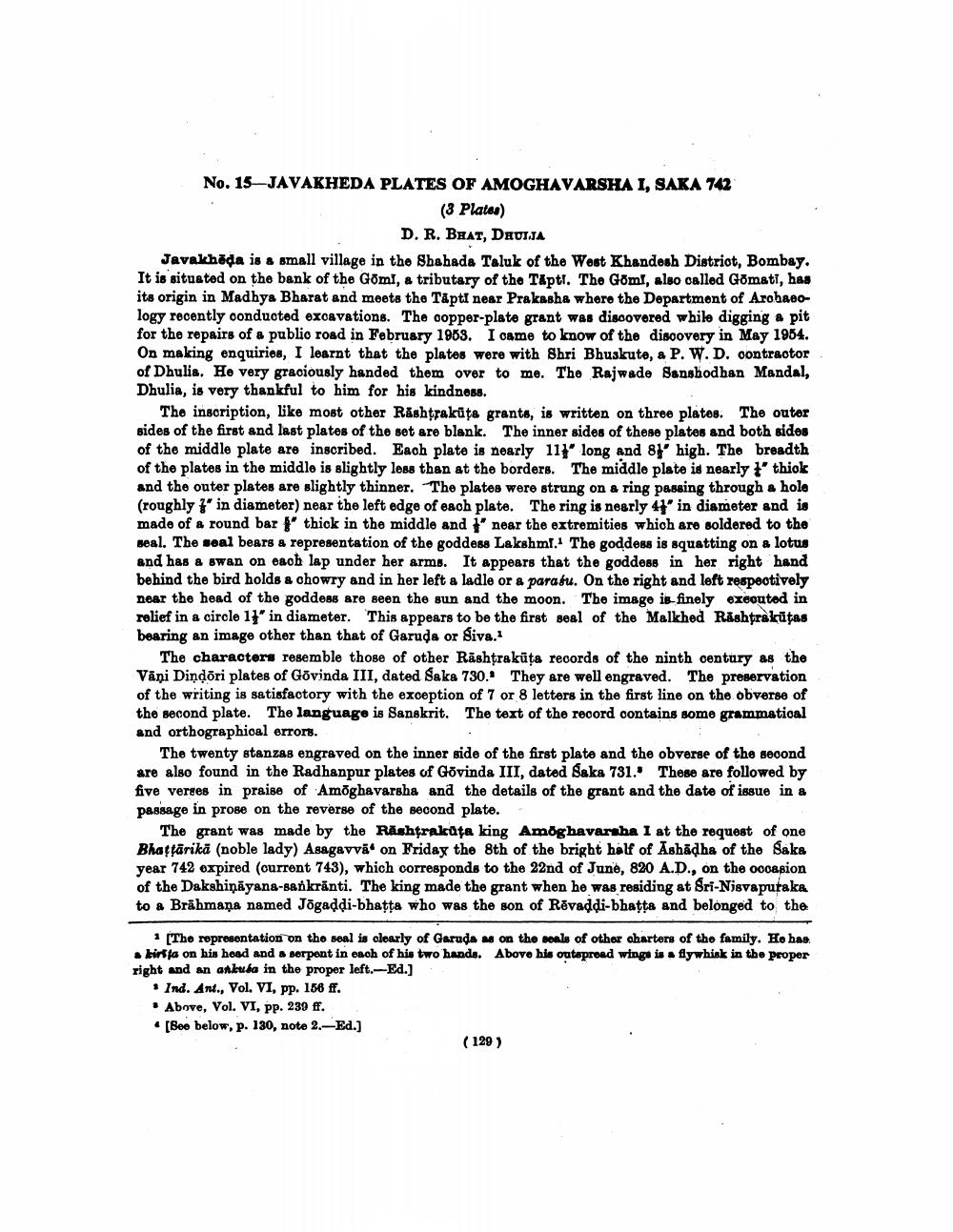________________
No. 15-JAVAKHEDA PLATES OF AMOGHAVARSHA I, SAKA 742
(3 Platos)
D. R. BHAT, DAUIJA Javakhoda is a small village in the Shahada Taluk of the West Khandesh Distriot, Bombay. It is situated on the bank of the Gomi, a tributary of the T&ptr. The Göml, also called Gomati, has its origin in Madhya Bharat and meets the Tapti near Prakasha where the Department of Archaeology recently conducted excavations. The copper-plate grant was discovered while digging a pit for the repairs of a publio road in February 1983. I came to know of the discovery in May 1954. On making enquiries, I learnt that the plates were with Shri Bhuskute, a P. W.D. oontractor of Dhulia. He very graciously handed them over to me. The Rajwade Sanshodhan Mandal, Dhulia, is very thankful to him for his kindness.
The inscription, like most other Räshtrakūta grants, is written on three plates. The outer sides of the first and last plates of the set are blank. The inner sides of these plates and both sides of the middle plate are inscribed. Each plate is nearly 111' long and 81' high. The breadth of the plates in the middlo is slightly less than at the borders. The middle plate is nearly t'thiok and the outer plates are slightly thinner. The plates were strung on a ring passing through a hole (roughly t' in diameter) near the left edge of each plate. The ring is nearly 41 in diameter and is made of a round bar " thick in the middle and near the extremities which are soldered to the Beal. The soal bears a representation of the goddess Lakshmi. The goddess is squatting on a lotus and has a swan on each lap under her arms. It appears that the goddess in her right hand behind the bird holds a chowry and in her left a ladle or a parabu. On the right and left respeotively near the head of the goddess are seen the sun and the moon. The image is finely executed in relief in a circle 11" in diameter. This appears to be the first seal of the Malkhed Rashtrakūtas bearing an image other than that of Garuda or Siva.
The characters resemble those of other Rāshțrakūta records of the ninth century as the Väni Dindori plates of Govinda III, dated Saka 730. They are well engraved. The preservation of the writing is satisfactory with the exception of 7 or 8 letters in the first line on the obverse of the second plate. The language is Sanskrit. The text of the record contains some grammatioal and orthographical errors.
The twenty stanzas engraved on the inner side of the first plate and the obverse of the second are also found in the Radhanpur plates of Govinda III, dated Saka 731. These are followed by five verses in praise of Amõghavarsha and the details of the grant and the date of issue in a passage in prose on the reverse of the second plate. -
The grant was made by the Răshtrakata king Amoghavarsha I at the request of one Bhattārikā (noble lady) Asagavvā' on Friday the 8th of the bright half of Ashādha of the Saka year 742 expired (current 743), which corresponds to the 22nd of June, 820 A.D., on the occasion of the Dakshiņāyana-sankranti. The king made the grant when he was residing at Sri-Nisva putaka to a Brāhmaṇa named Jõgaddi-bhatta who was the son of Révaddi-bhatta and belonged to the
[The representation on the seal is clearly of Garuda as on the souls of other charters of the family. He has kirta on his head and a serpent in each of his two hands. Above his outspread wings is a flywhisk in the proper right and an anbula in the proper left.-Ed.]
• Ind. Ant., Vol. VI, pp. 158 ff. • Above, Vol. VI, pp. 239 ff. [See below, p. 130, note 2.-Ed.)
( 129 )




